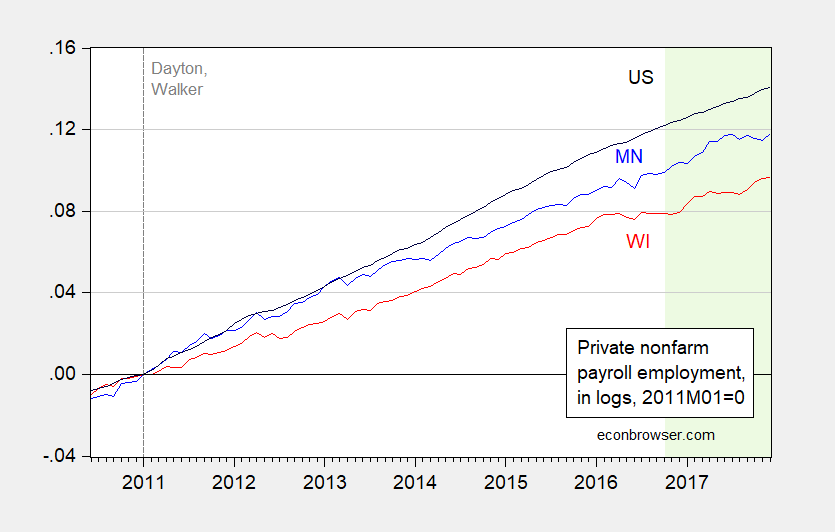Today, the DWD released statistics for December here. Total nonfarm payroll declined slightly, private increased slightly. The cumulative gap with respect to Minnesota (and the US) widened in both cases.

Figure 1: Nonfarm payroll employment in Minnesota (blue), Wisconsin (red), and US (black), all in logs normalized to 2011M01=0. Light green shaded dates indicates data not yet benchmarked using QCEW data. Source: WI DWD, MN DEED, BLS and author’s calculations.

Figure 2: Private nonfarm payroll employment in Minnesota (blue), Wisconsin (red), and US (black), all in logs normalized to 2011M01=0. Light green shaded dates indicates data not yet benchmarked using QCEW data. Source: WI DWD, MN DEED, BLS and author’s calculations.
Given the estimation error, these changes are probably not statistically different from zero.
The DWD release states:
- Place of work data: Based on preliminary data, Wisconsin added a significant 40,200 total non-farm jobs and 43,500 private sector jobs from December 2016 to December 2017, including a significant 11,500 manufacturing jobs. The state also gained 1,300 private sector jobs from November 2017 to December 2017, including 1,200 construction jobs. November private sector jobs gains were also revised up by
2,100, showing that Wisconsin gained a total of 4,900 private sector jobs from October 2017 to November 2017.
- Place of residence data: A preliminary seasonally adjusted unemployment rate of 3.0 percent in December matches the lowest rate on record, and sets a new record for lowest December unemployment rate. The unemployment rate decreased 0.2 percent from November’s rate of 3.2 percent and is 1.1 percent lower than the national unemployment rate of 4.1 percent, which was unchanged from November. Wisconsin’s labor force participation rate of 68.9 percent was unchanged from November, but the total labor force continued its strong growth, reaching another all-time high in December, preliminary estimates show.
Incidentally, nonfarm payroll employment is 1700 below the November peak; private nonfarm payroll employment is still 13,000 below the 250,000 new private sector jobs that Governor Walker committed to for January 2015.
Other macro indicators (GDP, personal income) discussed here have also stalled.
What about the growth of Hudson WI (St. Croix county) and other border towns where a lot of WI people work in MN and live in WI. Where are the stats on that piece of data, and it’s affects to the overriding message for MN an WI?
People are exiting the state making the unemployment numbers look good while new jobs number stays low.
https://www.unitedvanlines.com/contact-united/news/movers-study-2017
I will be leaving in June. It is time to get out before it turns into a cold version of Mississippi.